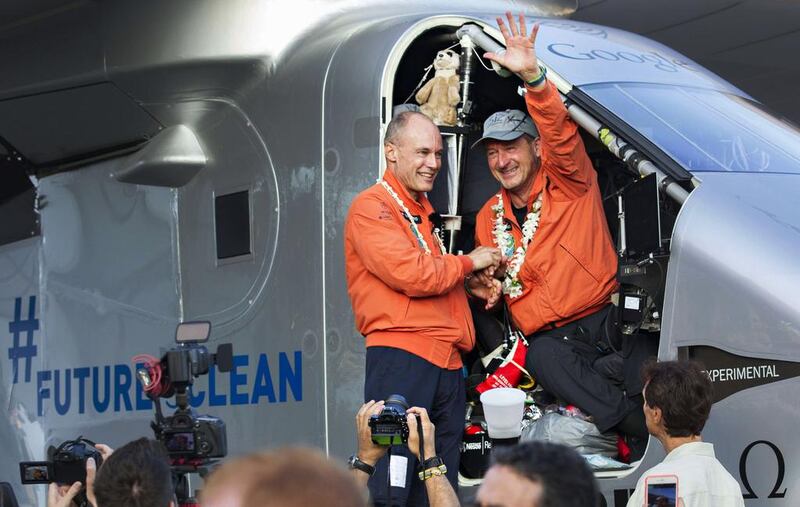ABU DHABI // Solar Impulse 2 on Friday overcame the most daunting leg of its round-the-world adventure, landing safely in Hawaii after a 120-hour flight over the Pacific from Japan.
Swiss pilot Andre Borschberg broke the world record for a non-stop solo flight in the process, smashing the previous record of 76 hours set by the late American adventurer Steve Fossett in 2006.
On Friday the fuel-free plane travelled the last 147km on the journey from Nagoya to Kalaeloa, flying at its average speed of 50kph.
Engineers at mission control in Monaco, including the principality’s Prince Albert, erupted in applause as the plane safely touched down at 7.55pm UAE time.
"8,259 kilometres, a historic first for aviation," said Conor Lennon, host of Solar Impulse TV, which was broadcasting live via solarimpulse.com.
“A flight that many thought would not be possible. Congratulations to the team.”
Fellow Swiss co-pilot Dr Bertrand Piccard, who has been taking turns with Borschberg to fly the plane, said it was “really an incredible moment”.
“When you imagine where he comes from, from Japan, 8,000 kilometres, five days, five nights in the air and you see the plane a few hundred feet away, it’s absolutely amazing,” said Dr Piccard, who is scheduled to pilot the next flight to Phoenix, Arizona.
Dr Sultan Al Jaber, Minister of State and chairman of Masdar, which is a Solar Impulse mission partner, said: “Today we celebrate Solar Impulse’s most defying round-the-world milestone after five days of non-stop flight.
“We were following the news of the trip from Abu Dhabi step-by-step and I would like to applaud the capability shown by the team by facing the challenges of the weather and difficult flying conditions.
“Finishing this stage is testimony to the maturity of renewable energy technology.”
Speaking to The National Emirati Solar Impulse team member Hasan Al Redaini said everyone on the ground was “thrilled”.
“Everyone is excited, everyone is happy,” the 25-year-old Mubadala employee said minutes after the landing.
“This is historic, never done before. We broke a few records and everyone is overjoyed. We proved that the plane can cross an ocean — five days and five nights.
“It took a lot of human challenges, technical challenges to prove that it’s doable, so everyone is thrilled. It’s a joy.
“We always say, if it were easy, someone would have done it before. It is not easy. It takes courage, it takes patience it takes perseverance.”
Borschberg and Dr Piccard have been on the round-the-world trip since taking off from Abu Dhabi in March. After Hawaii, the plane, which is equipped with 17,000 solar cells, will head to Phoenix then New York.
The project, which began in 2002 and is estimated to cost more than Dh367 million, is aimed at highlighting the importance of renewable energy and the spirit of innovation. However, solar-powered air travel is not yet commercially practical, due to the slow travel time, weather and weight constraints of the aircraft.
A departure date has not yet been set for the plane’s next flight but Solar Impulse 2 is scheduled to complete its journey in August in the UAE capital.
Borschberg has spent five days flying over the Pacific Ocean since taking off from Japan on June 28 for the eighth, and longest, leg of the round-the-world flight.
The zero-fuel plane is powered by the sun during the day. Solar energy is also used to recharge the batteries needed to operate the plane at night. Mr Borschberg had three oxygen tanks left, although he only needed one to complete this leg of the mission. His diet is made up of specially formulated snacks he eats several times a day to slow down his muscle loss in high altitude and his cockpit has an in-built toilet.
“During the fourth day I felt very tired, having climbed the equivalent altitude of Mount Everest four times,” Mr Borschberg tweeted on Friday morning. “It is delicate to maintain a balance between my energy and the energy of the aircraft.”
Before landing he performed holding patterns while awaiting sunrise, enabling the pilot to rest and prepare mentally for the high-risk landing, according to organisers.
Earlier on Friday, the flight got rather bumpy as Borschberg flew through unexpected cloud coverage but he came through unscathed.
In its record-breaking mission to circle the world in the single-pilot propeller plane without the use of fuel, the project aims to raise awareness of clean and alternative energy.
“Always feels good to break records but it is not the goal of @solarimpulse #futureisclean,” Mr Borschberg tweeted. “We are not going #RTW with @solarimpulse to break records but to demonstrate that clean technologies can really change the world!”
newsdesk@thenational.ae
* Additional reporting by AP






